Chin and Throat Treatments
Signs of ageing can appear on the chin and throat before they become obvious on the face.
When a woman is between twenty-five and thirty-five years old it is often hard to tell whether she is nearer to the upper or lower limit of this ten-year period. However, the truth about her age is usually betrayed in the lines of her chin and throat. If the skin under her chin is beginning to be flabby and withered, or if her jaws and neck are decidedly fleshy, the chances are that she is more than thirty. If, on the other hand, the lower part of her profile shows a clean-cut youthful line from lips to collar bone, you may be sure that she is in her twenties or else that she has mastered the secret of youth.
(Leeds & Kaji, 1927, pp. 104-105)
Early beauty specialists suggested a range of treatments for these conditions all based on a common understanding of the causes of the problems. It was widely believed that a flabby, crepey throat, unflatteringly known as a ‘chicken throat’ or ‘turkey neck’, was due to muscle weakness so the neck muscles had to be strengthened and tightened to renew the throat contour. On the other hand, fleshy necks, which produce ‘double chins’ and ‘Venus’ necklaces’, were the product of excess fat and this had to be removed if the chin line was to be restored.
Recommended throat treatments included massage, chin straps, exercises, and an assortment of throat creams, generally combined together rather than used in isolation.
Massage
The foremost treatment for flabby throats and double chins was massage. However, it had to be done with care as massage was believed to be capable of building up and breaking down tissue depending on how it was administered. Double chins needed a vigorous massage to break down the fatty tissue while a flabby throat required a more gentle, stroking action to build up the throat muscles.
The actual massaging must be done vigorously and with such strength that flesh will be literally rubbed away. If only slight pressure is used the stoking will be developing.
(Lefron, 1908, p. 46)
Both types of massage were usually combined with a skin preparation to improve their effectiveness. Vigorous massage with a reducing cream to help dissolve the fat, stroking massage with a skin food or muscle oil to help build tissue and muscle strength.
Also see: Massage, Wrinkles and Double Chins
A stimulating circulation cream, lotion or ointment could also be employed to improve blood flow. This would help ‘flush way’ material from the dissolving double chin and bring nutrients to flabby throat muscles.
Also see: Circulation Creams
A skilled masseuse could be relied on to apply the correct reducing or building massage in the salon but many beauty specialists thought that women might not be able reproduce this at home.
The muscle exercise of the neck is the most difficult of any form of massage for self-treatment. It should, if possible, be administered by someone skilled in the work, as the specialist will be able to give it more thoroughly and can reduce the fat or build up the tissue in places that a woman giving herself the treatment would have difficulty in reaching for proper manipulation.
(‘The neck,’ 1924, p. 74)
To help women with double chins achieve the necessary pressure many beauty experts suggested using a mechanical roller, electrical vibrator or something similar in place of the reducing massage. These were also employed by some salons. Electrical vibrators could be used by treatment girls who were not specialist masseuses and, unlike a manual massage, could also be applied over a chin strap in a combined treatment.

Above: 1929 Vibrator used over a chin strap in an Eleanor Adair salon.
Massage treatments were avoided by beauty experts like Elizabeth Arden and Dorothy Gray who thought that they would add to problem by stretching the skin. Along with their face treatments they substituted massage with a patter which could be used gently or vigorously depending on the need to strengthen or remove tissue. Like the previously mentioned rollers and electrical vibrators they were also sold to clients for follow up treatments at home.
Also see: Patters
Straps
Bandages and straps were another widely used salon and home treatment for the chin and throat with the straps coming in a wide variety of shapes and materials depending on how they were to be used. Clients showing signs of a double chin would be recommended to use a strap made from rubber to induce flesh-reducing sweating, while those with a flabby throat could employ a woven strap to support and strengthen the weak throat muscles. Some beauty experts went further suggesting that straps would help train the throat to regain the ‘habit of its original contour’, a notion that seems very strange to us today. The opposite view was also put forward with some beauty advisers warning that the throat muscles might grow lazy and sag if the strap was worn too long.
Straps and bandages were also used to hold the creams, lotions or ointments used in a chin or throat treatment firmly in place, obviating the necessity to do this by hand. A number of beauty companies recognised this and sold kits which combined a throat cream with a strap.
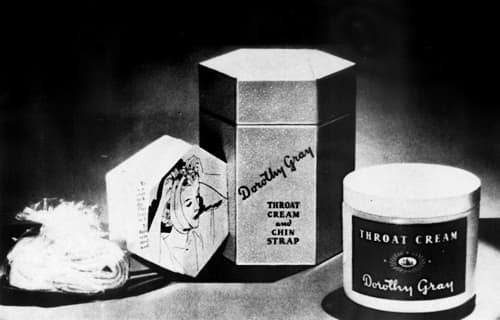
Above: 1936 Dorothy Gray Throat Cream, Chin Strap and instructions in a kit.
See also: Straps, Bandages and Tapes
Exercises
Neck exercises were another popular home remedy for the beautifying the chin and throat.
The beauty of the neck lies in just two things, its lines and its skin. If the former are ungraceful, they may be shaped to perfection by suitable exercises. Usually necks receive too little exercise. They are seldom stretched to their full extent so that the muscles either become swathed in fat or else they are shrunken and flabby.
(Leeds & Kaji, 1927, pp. 106-107)
Neck exercises did not changed much over the years, the main differences being whether or not they were done against resistance. Like those suggested by Harriet Hubbard Ayer at the turn of the century, most involved neck-bending and turning the head from side to side.
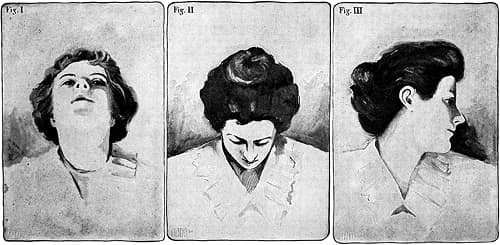
Above: 1899 Harriet Hubbard Ayer neck exercises.
The first movement consists in allowing the head to drop gently upon the breast, as far forward as it will without straining.
Next raise the head and throw it as far back as possible. Then forward again, etc., until the movement has been performed twenty times.
Next the head is turned as far to the side as possible, the body remaining motionless, the head bent toward the shoulder as low as it will reach without an actual strain of the muscles and tendons. This movement should be practiced also twenty times; the neck first turned to the right and then to the left, ten times on each side.
The same movement, with the chin raised as high as possible, repeated in the same fashion, first toward the right, then the left.(Ayer, 1899, p. 357)
Many beauty experts counselled that the benefits of neck exercises could be increased if they were done while wearing a chin strap – a rubber one to induce flesh-reducing sweating if the problem was a double chin, a cloth version to keep the chin and throat in place if the throat was flabby. These could also be combined with a suitable throat cream.
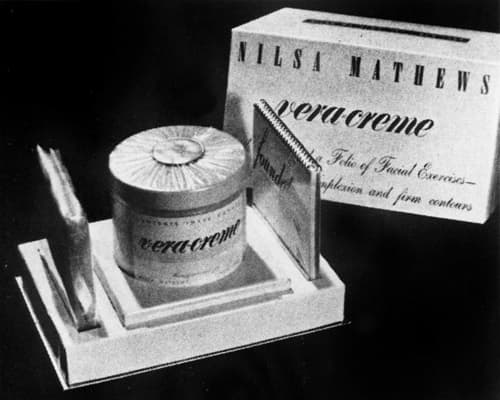
Above: 1939 Nilsa Mathews Vera-Creme combined with an exercise booklet and a chin strap.
See also: Facial Gymnastics
Throat creams, lotions and ointments
Most throat cosmetics sold for huse at home were aimed at flabby throats so generally combined ‘tissue-building’ fats and oils with ‘tightening’ astringents. The formulation given below contains lanolin, generally considered by the early beauty profession as a skin nutrient, and astringents such as zinc oxide. A circulation stimulant could be included if witch hazel was used in place of some of the water.
Throat Cream (parts) Lanolin absorption base 25.0 Petroleum jelly, white 11.5 Zinc oxide 6.0 Glycerine 5.0 Lactic acid 1.0 Ceresine 3.5 Perfume compound 0.5 Distilled water 47.5 If desired, the lactic acid may be reduced or omitted, or replaced by citric acid or strained lemon juice. Witch hazel may be employed in partial replacement of the water. Varying the petroleum jelly and wax alters the texture.
(Drug and Cosmetic Industry, July 1945, p. 132)
Also see: Skin Foods, Muscle Oils and Circulation Creams
Astringents were used in most throat treatments. They were essential in treatments to firm flabby throats but were also recommended in some double chin reduction treatments to prevent or remove any loose skin left after the fat was removed.
After strict dieting you may discover the double chin no longer noticeable except as a fold of loose skin. Pat briskly with ice-cold water or astringent to tone, brace and firm the skin.
(Elisabeth Ann, 1935, p. 59)
As indicated above, ice was also regarded as a muscle tightener so many treatments for the throat used it instead of, or as well as, an astringent. Like an astringent it could be used directly against the skin or over a bandage or strap.

Above: 1930 Icene treatment. This British device used a freezing mixture rather than ice.
Astringents could be applied with the fingers, a piece of absorbent cotton, or with a spray but it was also common to saturate a cotton wool pad with an astringent and hold this in position with the hand, a bandage or a chin strap. Some treatments for the throat used more than one, starting early in the treatment with a strong astringent in a cream or ointment, followed later in the routine with a milder astringent lotion.
See also: Skin Tonics, Astringents and Toners
Hormones found their way into throat creams in the 1930s. Many neck problems were associated with mature skin so it is easy to see why they were included. Foremost in hormone skin treatments was Helena Rubinstein. Her four-step throat treatment (1957) included massage, a circulation lotion, and an astringent in addition to the hormone oil. Note how she refers to the circulation lotion as a ‘liquid exerciser’.
SPECIAL FOUR-STEP THROAT TREATMENT
First, begin with a thorough cleansing. Smooth on a special cleansing, lubricating beauty cream, made on a pasteurized base. Be sure to apply it correctly. Smooth it on the throat upward from the base of the throat to the chin using firm, molding movements with the whole palms of your hands. Remove the cream with the same molding movements, using tissues or soft towel.
Second, apply a liquid exerciser, an active stimulant to arouse sluggish skin cells to action. You saturate a pad of absorbent cotton with this invigorating lotion and press it over the entire area.
Third, apply a balsam jelly to tighten and firm your contours. To hasten its effectiveness, slap your throat with the backs of your hands briskly and repeatedly. This brings the circulation singing up through the blood stream to revitalize those lazy, sagging muscles and tissues.
Fourth and final step, apply a rich oil containing estrogenic hormones, for the stringy, crepey throat. Smooth the oil all over your throat and neck with long, sweeping strokes of your fingers. Notice how quickly it is absorbed, as the dry, thirsty skin drinks in the beneficial liquid. This treatment is even more effective if you warm the highly penetrating oil.(Frasier, 1957, p.71)
See also: Hormone Creams, Oils and Serums
After the Second World War, a number of companies began selling a new preparation to correct sagging contours which was also used on the throat. These contour lotions varied in composition but generally contained a firming astringent and a film former that would tighten by contracting as it dried (Hilfer, 1953). Examples included Helena Rubinstein Contour-Lift Film, Germaine Monteil Throat Firmer, Elizabeth Arden Firmo-Lift Treatment lotion, Frances Denney Invisible Beauty Strap, Cyclax Neckline, and John Robert Powers Triumph Throat Lift. To help sustain the tightening feeling some preparations suggested using them under make-up during the day or beneath a night cream overnight. Like other throat treatments they were generally combined with other practices such as slapping the chin.
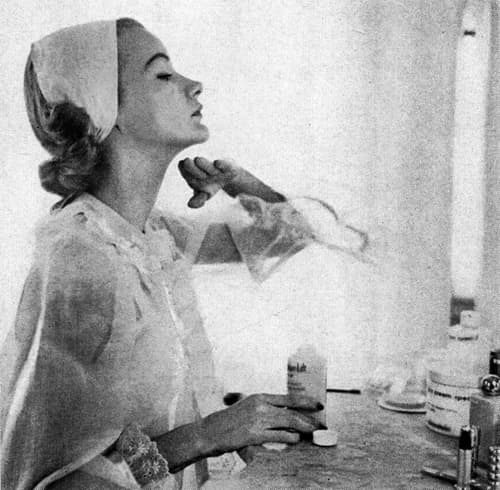
Above: 1952 Helena Rubinstein Contour-Lift Film.
Contour-Lift Film is a pleasant, soft, non-greasy fragrant liquid in an appealing flesh tone which disappears immediately on the skin. A rare blend of beneficial herbal extracts, effective astringents and rich, replenishing oils, it is non drying and quickly beneficial. It sinks in instantly and invisibly starts its remarkable lifting, tightening and firming action. The whole complexion feels former, takes on a radiant young glow. Use by day under make-up it provides a firming treatment. Used at night under your nourishing cream as part of a corrective treatment, it tightens, “uplifts”.
(Helena Rubinstein, c.1956, p.18)
Salon treatments
Many salon treatments for the flabby throats and double chins could be repeated at home if the client bought the necessary devices and preparations. However, salons had access to electrical machinery generally unavailable to women at home. Salon electrical treatments for the neck were: high-frequency, heat, and diathermy treatments to improve circulation; heat, diathermy, and iontophoresis treatments to enhance the penetration of skin preparations; and what can be loosely called faradic treatments to electrically exercise and tone the throat muscles. I have discussed all these treatments elsewhere and will not repeat them here.

Above: 1932 Student demonstration of a high frequency treatment applied over a chin strap.
See also: High-Frequency Treatments, Diathermy, Iontophoresis and Faradic Treatments
Skin tone
Before leaving the subject of the throat there is one other problem that deserves a mention – unwanted changes in neck colouration due to stains or sun exposure.
Prior to the First World War, fashionable European complexions were a pale white. The sun was avoided but the neck could still be darkened by stains from metal trimmings and/or the poorly fixed dyes used to colour furs and other clothing. Beauty writers like Lina Cavalieri [1874-1944] recognised this problem and provided some useful advice.
To prevent such stains avoid wearing dark colors next to the neck. If the dark collar is unavoidable then line it with something soft and white, old muslin or part of an old silk handkerchief.
(Cavalieri, 1914, pp. 43-44)
If the neck was stained then lemon juice, weak hydrochloric acid, or hydrogen peroxide could be used to remove it. Salons generally used hydrogen peroxide with its strength adjusted to suit requirements.
Should a woman be careless and get their neck browned by the sun during an outdoor activity, such as cycling or sea bathing, then some sort of skin lightening treatment might be needed. Harriet Hubbard Ayer [1849-1903] suggested the following paste:
Honey, one ounce; lemon juice, one teaspoonful; oil of bitter almonds, six drops; the whites of two eggs and enough fine oatmeal to make a smooth paste.
(Ayer, 1902, p. 251)
When sunbathing and suntanning became fashionable between the two world wars, an end-of-summer, fading tan became an increasing problem for women wanting to go from the beach in summer into a low-cut evening dress in the autumn, particularly if the tan was uneven or included strap marks. Many women resorted to bleach to remove any lingering brown once their beach holiday was over. Those with the necessary funds booked in for a series of salon treatments as removing any lingering tan might take a number of visits.
See also: Bleach Creams
Another solution to stained or sun-browned skin was to cover the neck, décolletage and shoulders with a liquid powder. Before the First World War most of these powders were white but by the 1920s a Rachel shade was preferred for darker skins while Naturelle was suggested for those that were fair. Both shades could also be used to correct any tendency towards sallowness.
See also: Liquid Face Powders
First Posted: 4th January 2022
Last Update: 28th February 2023
Sources
Ayer, H. H. (1902). Harriet Hubbard Ayer’s book; a complete and authentic treatise on the laws of health and beauty. New York: King-Richardson.
Cavalieri, L. (1914). My secrets of beauty. New York: The Syndication Syndicate, Inc.
“Chrysis” (1932) Contour. Britannia & Eve, April 1, 87.
Elisabeth Ann. (1935). Beauty adorned. London: Methuen & Co. Ltd.
Elizabeth Arden. (c.1939). Foundations of beauty: A little book of instructions [Booklet]. USA: Author.
Fraser, H. (1957). The charming woman New York: Charming Woman, Inc.
Fulton, V. N. (1929). The rainbow textbook of beauty culture (2nd ed.). Indianapolis, IND: Zinna Graphic Press.
Helena Rubinstein. (c.1956). Beauty for you: Every woman’s ABC of skin care hair care and make-up [Booklet]. Sydney: Author.
Hilfer, H. (1953). Contour lotions. Drug and cosmetic Industry. March. 72(3), 324-325.
The importance of being beautiful: The neck. (1924). Vogue. August 15, 54-55, 74.
Leeds, L., & Kaji, H. M. (1927). Beauty and health a practical handbook. Philadelphia, PA: J. B. Lippincott Company.
Lefron, J. (1908). The road to beauty. New York: Berkowitz & Proper.
McLeod, E. T. (1949). Beauty after forty. Garden City, NY: Nelson Doubleday, Inc.
Prescott, A. (1906). The woman with the double chin. Smith’s Magazine. September. 3(6), 1008-1012.
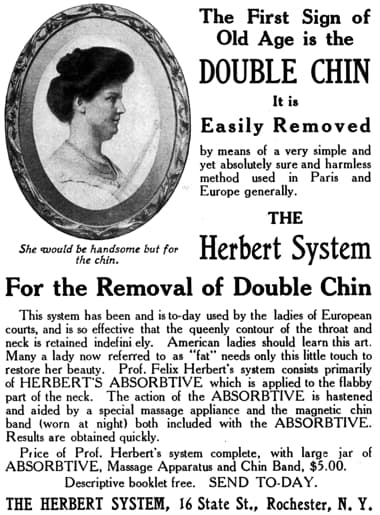
1908 Herbert System.
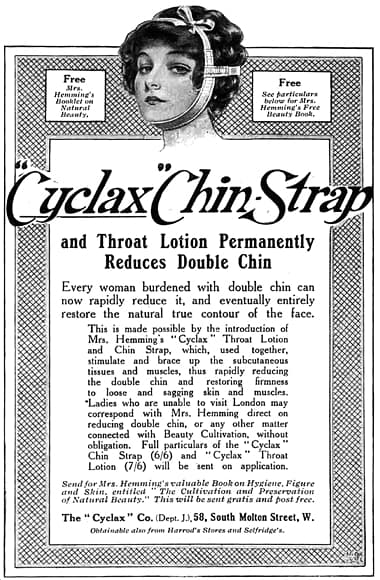
1914 Cyclax Chin Strap and Throat Lotion.
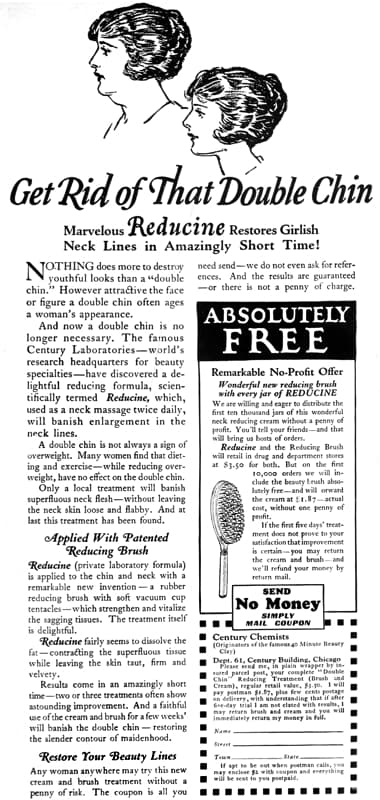
1923 Century Cosmetics Reducine.
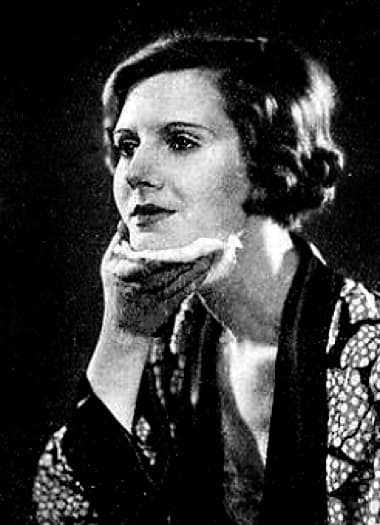
1925 Holding a pad of astringent against the throat.

1927 Génovar Vinaigre for a double menton (France).
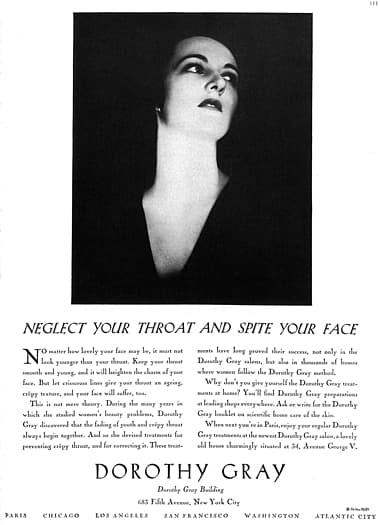
1930 Dorothy Gray.
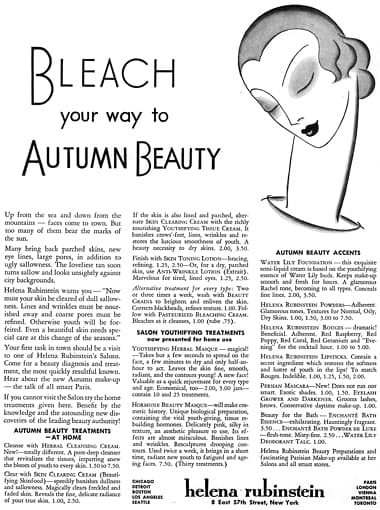
1934 Helena Rubinstein bleach treatments.
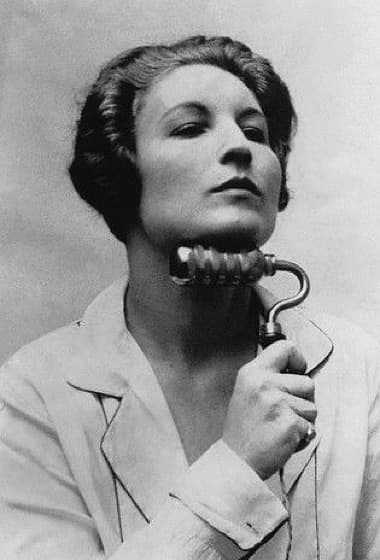
1936 Chin roller.
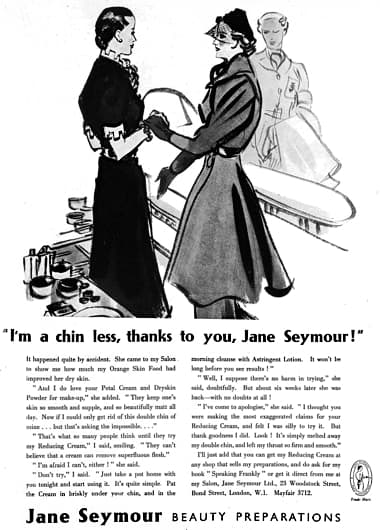
1937 Jane Seymour.
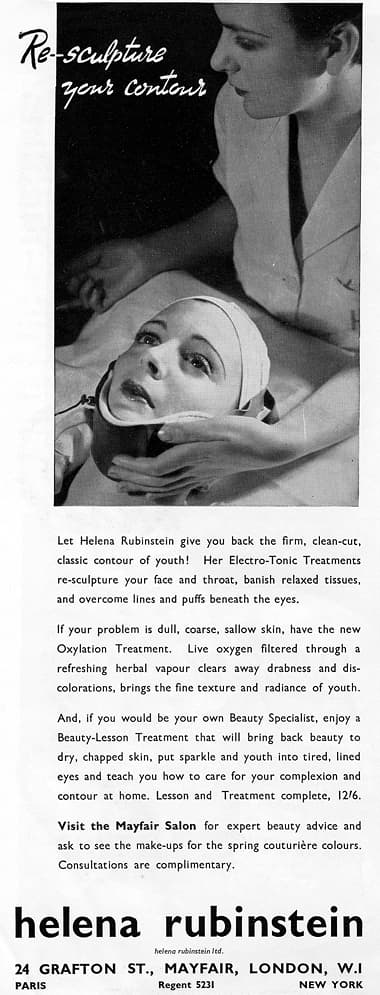
1939 Helena Rubinstein Electro-tonic Treatment.
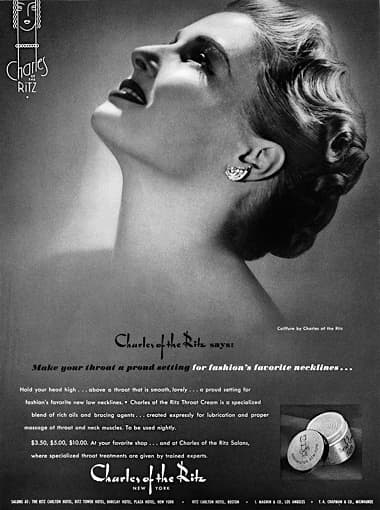
1939 Charles of the Ritz Throat Cream.
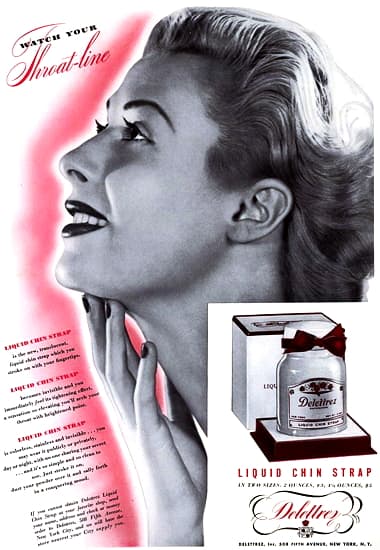
1941 Delettrez Liquid Chin Strap.
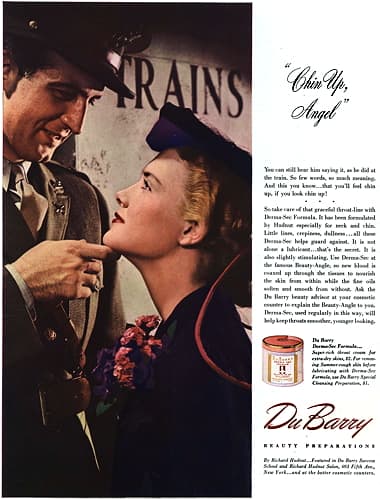
1942 Richard Hudnut Du Barry Derma-Sec.
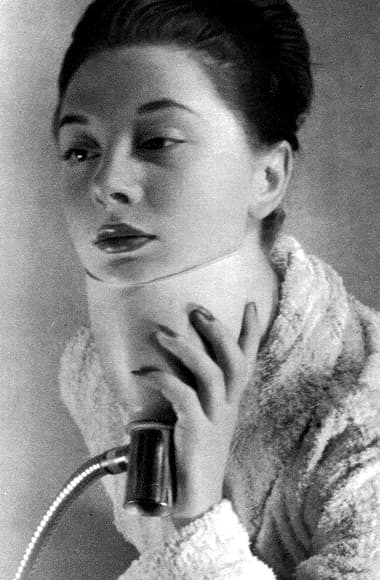
1949 Hydromassage treatment for the throat. Cold or hot water could be used (France).
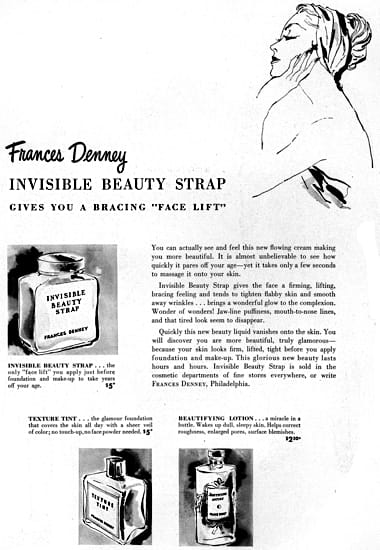
1952 Frances Denney Invisible Beauty Strap.

1955 Elizabeth Arden Firmo-Lift.
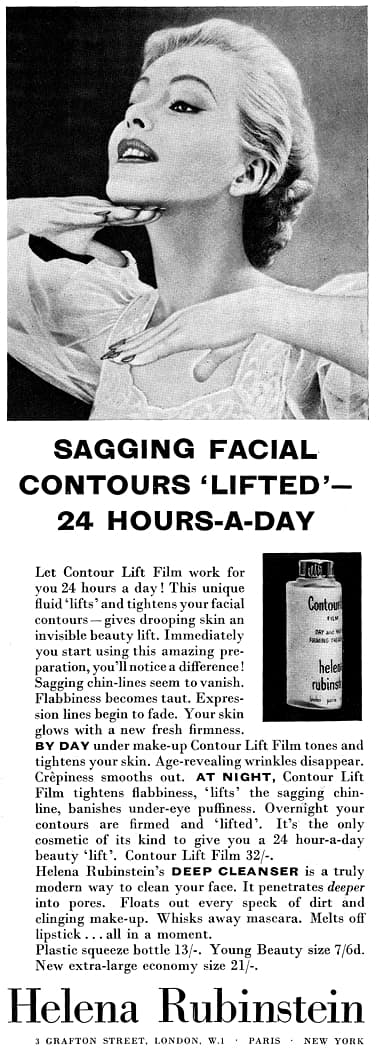
1957 Helena Rubinstein Contour Lift.

1962 Germaine Monteil Throat Firmer Cream.
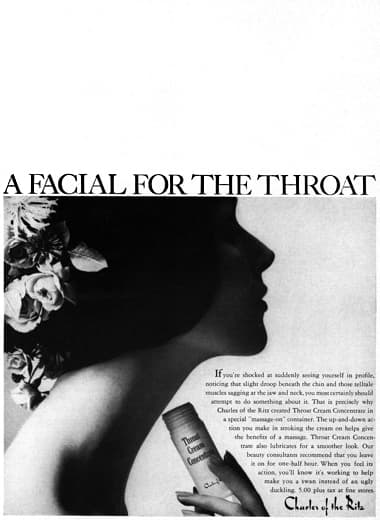
1965 Charles of the Rtiz Throat Cream Concentrate.
